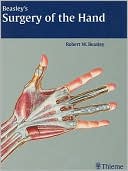

 |

|

The average rating for Beasley's Surgery of the Hand based on 2 reviews is 4 stars.
Review # 1 was written on 2014-12-06 00:00:00 Linda Neighborgall Linda Neighborgall"Conclusion: What Is Medicine?" Art of medicine is concernd about the whole person not simply the diseased organ. Swift believed art implies creation of special conditions from available material (which in medicine are prepared by science.) He demarcated two roles for art in medicine; the manner in which knowledge may be applied and also the assist of art in the technique for acquiring new knowledge. Since antiquity, medicine is connected to natural sciences, but actually it was after William Harvey discovered circulation in 17 century that medicine was accepted as science. For William Welch medicine was rational, observational, inductive, and physical. Later, Fultom said that medicine is the analysis of normal and pathological processes of the body in terms of physical and chemical laws, with the end of therapy. Some claimed that medicine is not a science beacase its goal is to reliece suffer, but the aim of science is to acquire knowledge. Some think that medicine is a social science and to understand the patient, doctors should consider the social influences on the origins, explanation, and prevention of disease. Finally, Pellegrino suggest that every physician himself/herself should deside how to combine these two aspects (art and science). * Evidence-based medicine should be practised in five steps. Finding patient's problem, searching in PubMed, appraisal, applying the evidence to the patient's problem, and finally an evaluation of the effectiveness of the process. Some said before EBM, medicine did used evidence. Also in EBM there are different opinions which conflict. Evidence is obtained from population-based studies, so it is not applicable to any individual patient. And there is this ethical question that does the patient wants to undergo the treatment based on the best evidence. Finally, EBM is very much related to clinical judgment which is more akin to casuistry than to scienctific rationality. In Patient-Centered Medicine, unlike EBM, humanistic and biopsychosocial perspectives are importat. It's not doctor-centered, but the focus is on patient's illness experience. PCM's goal is effective communocation. A robust medicine will arise when PCM and EBM are combined. There is also a Narrative-Based Medicine which stress on listening to the illness story. Value-Based Medicine "integrate the best EBM data with the patient-perceived quality of life improvement by a healthcare intervention". It makes healthcare more cost-effective. |
Review # 2 was written on 2014-08-21 00:00:00 Jeffrey Pollack Jeffrey PollackThis book leans more heavily towards the "Introductory Philosophy" and away from the "of Medicine." The book consists of three sections (Metaphysics, Epistemology, and Ethics'simple enough) and each section is divided into five chapters, most of which weren't worth the time (were I to diagnose the book I would say that there is some sort of benign growth). Many of the chapters present a sub-SEP level of philosophy, with some tenuous connection to medicine. To use as an example (or, a case study, if you will), there is the second chapter in the Metaphysics section: "Medical Causation and Realism." The chapter's first sentence typifies many of the issues with the book as a whole: "Causation and realism are two important notions that are essential for understanding any worldview, especially medical worldviews." The main clause of the sentence concerns philosophy with (a grammatically-incomplete) "especially medical worldviews" thrown on the end for good measure. The rest of the chapter devotes most of its space to either historical understandings of causation or the various positions within realism or anti-realism. The connection to medicine (ostensibly the point of the book) amounts to saying that physicians who use a biomedical approach tend towards realism whereas those who prefer a humanistic approach to medicine tend towards anti-realism. The final problem I'll mention is that the connections to medicine invariably involve breaking physicians into two categories: those who prefer the biomedical approach on the one hand, and humanistic ones on the other. From this point, he then will comment how the biomedical approach has been useful and effective thus far, but has contributed to the quality-of-care crisis. He's almost certainly correct that the biomedical approach has contributed to the quality-of-care crisis, but this is hardly groundbreaking (or worth writing a dozen times). Thus, the book becomes reductive and formulaic'which funnily enough, is the major failing of the biomedical approach. |
CAN'T FIND WHAT YOU'RE LOOKING FOR? CLICK HERE!!!